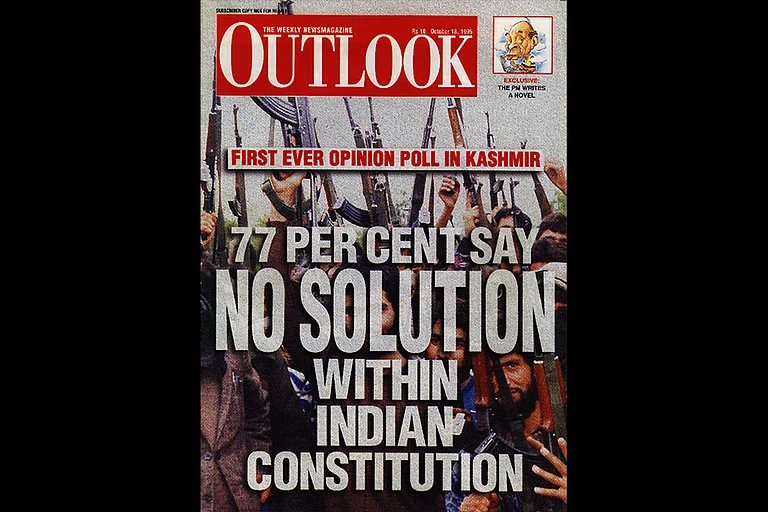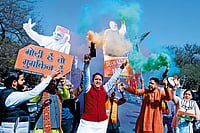Hinduism and neoliberalism emerged as strange bedfellows in India at the turn of the century. Postcolonial India was prided for its somewhat sacred separation between spirituality and materiality. It was often argued that even under colonial rule, the ‘inside’ India, marked by its spiritual pursuit, remained sovereign, and it was only the ‘outside’ that got colonised by materiality, the market and technology. In today’s—or rather Modi’s—‘New India’, the market and spirituality are having a gala time together in a bonhomie that is here to last.
What is even more important to note is that both Hinduism and neoliberalism are decentred and decentralised. Hinduism is more of a ‘way of life’ encompassing countless local practices, whereas neoliberalism is a faceless post-Westphalia phenomenon without an anchor. In a sense, both Hinduism and neoliberalism have no nation or sanctum sanctorum to reach out to.
In an earlier articulation, Gandhi struck a chord by mobilising diversity in all its beauty, and the Congress party, in its post-independence avatar, became representative of a decentred polity with the state through its planning and welfare-oriented social democratic vision—a conduit to hold dispersed realities together. India was classically typified as a ‘nation in the making’. Neoliberalism replaced the centrality of state and welfare and replaced it with the processes of globalisation and privatisation.
The emergence of an omnipresent Modi is the personification of this transformed, ‘Modi-fied’ reality. Modi represents the uncertainty that Hinduism came to represent in neoliberal times. Both the processes lacking an anchor gave rise to a mass psyche of insecurity, confusion and a sense of directionlessness. In such a context, Modi rose to fame with a larger-than-life image that can provide the new anchor.
The decentred and accommodative character of Hinduism was eschewed for a more militant rhetoric. It converted Hinduism into a more organised religion and with greater intensification of neoliberal reforms, economic reforms were no longer ‘merely’ economic but underwent a metamorphosis into a process of culturalisation. The economy began to make sense in cultural terms. Greater global integration was typified as India coming of age and a potential vishwaguru.
Rashtriya Swayamsevak Sangh (RSS) chief Mohan Bhagwat believes India does not need the world but the world is dependent on India. India is the new global machine aiming to become the third-largest economy with a $5 trillion GDP projected to be round the corner. It is this wholesome change in the terms of reference that made Modi omnipresent and completely tuned into this reality, accompanied by media extravaganza.
The faceless exploitation, expropriation and dispossession of neoliberalism was sought to be offset by an organised Hinduism and a rebooted polity around stability and security. Both Hinduism and nation were marked by a singularity. Hinduism was now imagined around Lord Ram and a bhavya mandir (huge temple) in Ayodhya and the nation moved to the unapologetic rhetoric of one nation, one market, one poll and one leader.
The emergence of a presidential form of politics around one leader is how the state under neoliberal times tends to become responsive and accountable. Politics moved from being represented by a family-dynasty to a single leader. Dynasty was rejected for its undemocratic character, but a singular titular head was endorsed for the same reason! The imagination of a single unquestioned leader moved from being understood as authoritarian during Indira Gandhi’s times to being self-made, hardworking, selfless, ascetic, celibate and without a family to fall back on and gained greater significance. Ascetic authoritarianism became more ethical than family rule.
The shift to an omnipresent leader signified the shift from welfare to efficiency and being atmanirbhar (self-dependent). It signified the shift from universal welfare schemes to direct cash transfers. It was also signified by direct democracy and referendum-style politics over deliberative democracy. In essence, it represented the neoliberal imagination of speed and scale over people.
The language of speed and scale justified certain predatory ruthlessness that, in turn, got reflected in the ejaculatory euphoria around the fastest train, largest statue, longest bridge, and greatest leader, among others. The question of speed for what was supplanted by speed itself became the new meaning of a nation’s existence.
Every occasion has a differently-clad Modi. This ipso facto signifies, there is no ‘real’ Modi, and, therefore, there cannot possibly be an image-trap.
The speed and scale opened and reinforced justification for offensive emotions and aggressive assertion. Militant incivility replaced protest politics. But all of this was cushioned in the personalised politics and reassured intimacy of the leader. Aggression was collective, intimacy was personal, and it reached through the monthly mann ki baat and also through the performative emotional breakdown of the supremo in Parliament and party meetings. Above all was the spectacle of the everyday life of the leader, including his nonchalant visits to pay homage to his mother.
Invasive cameras reminded us that authenticity lay in its demonstrative potential—jo dikhta hai, woh bikta hai (whatever is seen, sells). The brazenness of the spectacle castigated Gandhian silence as effeminate and new intimacy as masculine. Modi not only transformed but partially succeeded in erasing the memory of the past. Erasure was a necessary coping strategy. Spirituality too made sense only if it could be marketed and only if it could usher in more development and profits. The development paradigm too underwent a ‘shock and awe’ treatment, which was no longer about development with a ‘human face’ but development now meant unapologetic accumulation.
In this juggernaut, religion cannot become a hindrance but an endorsement. For Nehru, dams were the temples of modern India, for Modi, temples are the dams of development in New India. Infrastructural development of roads was linked to pilgrimage with the inauguration of the Kashi-Vishwanath corridor. Similarly, Lakshadweep could replace the Maldives and cost them a loss of Rs 800 crore in order to boost Indian tourism.
Religion is a source of accumulation, unlike the Gandhian maxim of ‘materialism with moralism’. It is the ruthless pragmatism of business ethics that is the new civic ethos. Any critique of the development now meant in common sense both anti-Hindu and anti-India. Religion and nation are beyond question, and so is by default anything remotely connected with them. It is this unquestioning character that makes Modi’s omnipresence seditious.
What can possibly exist beyond this horizon?
Modi’s omnipresence, however, is not the replica of earlier models of leadership. Even Mrs Gandhi, and various regional leaders like MGR and NTR, had a larger-than-life image. However, what they projected turned out to be an image trap leading to their decline in public perception. Modi skirts the image trap by openly embracing self-contradictory posturing. What he does is welfare for labarthis but what the Opposition pursues is revdi; he is a warrior of corruption but those who join him are pardoned of charges of corruption; even as women wrestlers are abandoned on the streets, Modi could give out a call for ‘beti bachao, beti padhao’; protesting farmers were Khalistanis but Modi withdrawing the farm laws is not anti-national.
One can go on with such absurdities but it seems to not dent the image because it is made independent of these considerations. It is, in fact, a result of such challenges in the political life of the nation. Modi is conscious and therefore an image makeover is a ‘way of life’.
Every occasion has a differently-clad Modi. This ipso facto signifies there is no ‘real’ Modi, and, therefore, there cannot possibly be an image trap. Has it turned a full circle? An image that was made to circumvent and overcome the elusive nature of Hinduism has only produced an equally elusive political persona. How does one make sense of this supra-contradiction that the leader who has promised absolute stability himself has no fixed persona? How are people reading his overwhelming presence and his omnipresence in this ‘absent presence’ of shifting imageries? Does the mobius psychology behind the predatory imagery, that can also be compassionate for those counted as authentic, open up new spaces or close down all critiques?
It is this chaos that is currently marking Indian politics, and more so, electoral outcomes. Even as the mirage of an opposition comeback is created, it seems to disappear as we move closer. It is as much an illusion as it is a reality. The maya of Hindu psyche, its ability to see plurality and the rundown transactional pragmatism of business ethics that cannot appreciate anything beyond its acquisitive pursuit are strangely cohabiting together.
Modi is the patron who has made this possible. Will this leave enough stuff for common sense to make a comeback? Or has it altered so much that we don’t seem to recognise ourselves? What one can conclude with some degree of clarity and confidence is that this is a machine that will work its magic only as long as it’s running. There is no resting place here. How long can it run without a glitch? It needs to continuously reinvent itself to allow speed to remain relevant but that has to match with creativity and incessant ‘invention of traditions’. We might be witnessing somewhat jaded and repetitive rhetoric that needs spirituality to rescue it. Modi’s omnipresence rests on its unpredictability. Will that also erode in unpredictable ways?
(Views expressed are personal)
(This appeared in the print as 'A ‘Modi-Fied’ Reality')
MORE FROM THIS ISSUE
Ajay Gudavarthy is Associate Professor, Jawaharlal Nehru University, New Delhi































